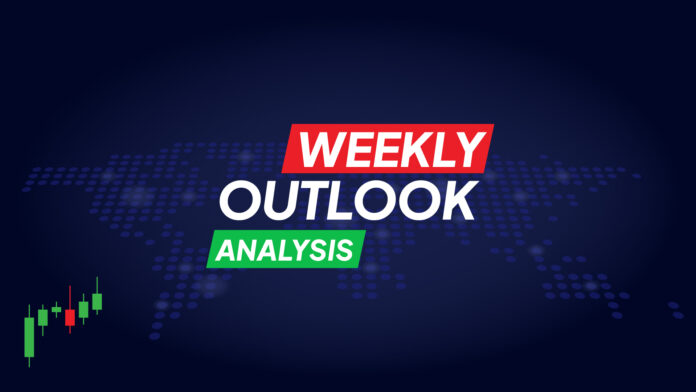Key Points to Watch:
- U.S. Elections on Tuesday: Trump and Harris in a Tight Race
- Federal Reserve’s Decision on Interest Rates
- Monetary Policy Announcements from the Reserve Bank of Australia (RBA) and Bank of England (BoE)
U.S. Election Impact on the Markets
The U.S. dollar has strengthened recently, supported by optimistic data suggesting the Federal Reserve may not need to make another 50-basis-point rate cut for the remainder of 2024. Additionally, market bets are growing on a potential victory for Donald Trump and his return to the White House.
The time has come for U.S. citizens to decide if this will indeed be the case. While some voters have already cast ballots, the official election day is Tuesday, November 5, with candidates Donald Trump and Kamala Harris going head-to-head for the Oval Office. Although Harris entered the race with a decent lead, this advantage has narrowed considerably, with the outcome likely to hinge on swing states.
Trump has promised tax cuts and import tariffs, particularly on Chinese products—policies seen as inflationary. Consequently, a Trump victory could lead to speculation about an even slower pace of interest rate reductions by the Fed, potentially boosting U.S. Treasury yields and the dollar.
The question is how the stock market will respond. Tax cuts and deregulation could be positive for Wall Street, although tariffs and a slowdown in rate cuts may not be. Consequently, even if stocks rally following a Trump win, a pullback may occur in the near future.
With the dollar and Wall Street rising on growing bets of a Trump victory, a likely Harris win could have the opposite impact on the market, given that her plans do not include massive tax cuts like Trump’s. That said, the application of any policy will depend entirely on the composition of Congress.
What Will the Federal Reserve Do After the Elections?
We may get an initial sense of how the election results could influence the Fed’s thinking a few days later when the Committee announces its monetary policy decision on Thursday, November 7. Since recent U.S. data indicates improvement and suggests little need for a consecutive rate cut, investors anticipate 25-basis-point cuts at both the November and December meetings.
However, a 25-basis-point cut this week isn’t guaranteed, as the market’s reaction to the NFP report must be observed. A possible Trump victory on Tuesday could persuade more policymakers to align with Atlanta Fed President Raphael Bostic, who has advocated skipping a meeting. The Fed may either skip this week’s meeting or carry out the expected cut without surprising investors and hinting at a pause in December. After all, Fed funds futures show about a 30% chance of a pause in December if a cut occurs this week.
Given current market prices, both scenarios support further gains for the U.S. dollar. For the dollar to face significant selling pressure, Fed policymakers would need to express concern about the U.S. economy and signal the need for aggressive easing in the coming months. However, this scenario appears unlikely.
The RBA and BoE Also on This Week’s Agenda
The Fed meeting is not the only monetary policy decision on this week’s agenda. The week kicks off during the Asian session on Tuesday, November 5, with the Reserve Bank of Australia, followed by the Bank of England’s rate decision on Thursday, just before the Fed’s announcement.
The Reserve Bank of Australia May Keep Rates Steady
In its last September decision, the RBA keeps rates unchanged, noting that underlying inflation remains elevated and projecting it will take some time to reach the Bank’s target range. The Board reiterated that it would continue relying on data and do everything within its means to ensure price stability.
With the Melbourne Institute (MI) indicating that inflation could reach 4.0% in 12 months, it’s difficult to foresee an RBA strategy resembling that of other central banks worldwide, many of which have already started cutting rates. In fact, market participants estimate only a 20% chance of a 25-basis-point cut by the end of 2024, with this measure fully anticipated by May 2025.
Investors will therefore be watching the statement to see if the RBA will remain on hold for an extended period. If confirmed, the Australian dollar may gain some ground, though it’s unlikely to reverse its recent downtrend against the U.S. dollar until investors are convinced that China will implement significant economic support measures.
A Rate Cut by the Bank of England is Becoming More Likely
Turning to the Bank of England, policymakers decided to keep interest rates steady at 5.0% during their September meeting, noting they would be cautious about future rate cuts.
However, BoE Governor Andrew Bailey recently suggested they might need to act actively with rate cuts if inflation data continues to show progress. In fact, September figures showed headline CPI fell to 1.7% year-over-year from 2.2%, while core inflation dropped to 3.2% year-over-year from 3.6%.
This has led market participants to assign an 80% probability of a 25-basis-point cut at this week’s meeting, with a 30% chance of an additional quarter-point cut in December.
Thus, a rate cut alone is unlikely to weigh down the pound. Focus will be on the voting results and policymakers’ communication. If the vote reveals a close decision and a lack of urgency for further cuts, the pound may strengthen. Conversely, the pound could decline if further cuts are signaled.
Conclusion
Finally, employment reports from New Zealand and Canada are due on Tuesday, November 5, and Friday, November 8, respectively. The RBNZ is expected to implement a consecutive 50-basis-point cut on November 27, with investors assigning a 15% chance to a larger 75-basis-point cut. The BoC, which recently cut rates by 50 basis points, currently has a 35% chance of implementing another double cut.
In this context, weak employment data from these countries could prompt more market participants to bet on more aggressive measures from their respective central banks.



